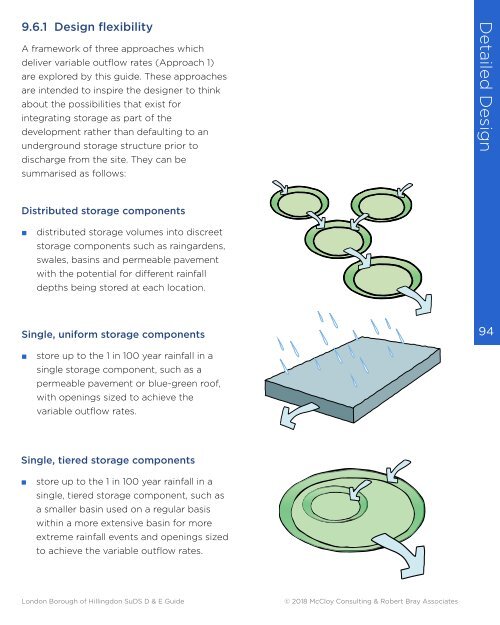Hillingdon SuDS Design & Evaluation Guide
You also want an ePaper? Increase the reach of your titles
YUMPU automatically turns print PDFs into web optimized ePapers that Google loves.
9.6.1 <strong>Design</strong> flexibility<br />
A framework of three approaches which<br />
deliver variable outflow rates (Approach 1)<br />
are explored by this guide. These approaches<br />
are intended to inspire the designer to think<br />
about the possibilities that exist for<br />
integrating storage as part of the<br />
development rather than defaulting to an<br />
underground storage structure prior to<br />
discharge from the site. They can be<br />
summarised as follows:<br />
Detailed <strong>Design</strong><br />
Distributed storage components<br />
■■<br />
distributed storage volumes into discreet<br />
storage components such as raingardens,<br />
swales, basins and permeable pavement<br />
with the potential for different rainfall<br />
depths being stored at each location.<br />
Single, uniform storage components<br />
94<br />
■■<br />
store up to the 1 in 100 year rainfall in a<br />
single storage component, such as a<br />
permeable pavement or blue-green roof,<br />
with openings sized to achieve the<br />
variable outflow rates.<br />
Single, tiered storage components<br />
■■<br />
store up to the 1 in 100 year rainfall in a<br />
single, tiered storage component, such as<br />
a smaller basin used on a regular basis<br />
within a more extensive basin for more<br />
extreme rainfall events and openings sized<br />
to achieve the variable outflow rates.<br />
London Borough of <strong>Hillingdon</strong> <strong>SuDS</strong> D & E <strong>Guide</strong><br />
© 2018 McCloy Consulting & Robert Bray Associates


